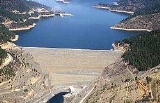
Trinity Dam
Encyclopedia
Trinity Dam is an earth dam
on the Trinity River
that forms Trinity Lake
near Weaverville, California
. Trinity Lake was previously called Clair Engle Lake. The 538 feet (164 m) earthfill dam was built by the U.S. Bureau of Reclamation. Construction was completed in 1962. Trinity Lake has a capacity of 2447650 acre.ft, making it one of the largest reservoirs
in California
. Trinity Lake and Dam are part of the Central Valley Project
, which harnesses the waters from the Sacramento River
and San Joaquin River
watershed
s to irrigate
the Central Valley
. The area around the reservoir forms one of the three units of the Whiskeytown-Shasta-Trinity National Recreation Area
.
Trinity Power Plant is a hydroelectric plant located at the base of the dam. The power plant has a capacity of 140 megawatts with two Francis turbine
s. The plant operates on a peaking
basis.
Dam
A dam is a barrier that impounds water or underground streams. Dams generally serve the primary purpose of retaining water, while other structures such as floodgates or levees are used to manage or prevent water flow into specific land regions. Hydropower and pumped-storage hydroelectricity are...
on the Trinity River
Trinity River (California)
The Trinity River is the longest tributary of the Klamath River, approximately long, in northwestern California in the United States. It drains an area of the Coast Ranges, including the southern Klamath Mountains, northwest of the Sacramento Valley...
that forms Trinity Lake
Trinity Lake
Trinity Lake, previously called Clair Engle Lake, is a lake on the Trinity River formed by the Trinity Dam and located in Trinity County, California, The dam was built by the U.S. Bureau of Reclamation. The lake has a capacity of , making it one of the largest reservoirs in California. The lake's...
near Weaverville, California
Weaverville, California
Weaverville is a census-designated place and the county seat of Trinity County, California. The population was 3,600 at the 2010 census, up from 3,554 at the 2000 census.-History:Founded in 1850, Weaverville is a historic California Gold Rush town...
. Trinity Lake was previously called Clair Engle Lake. The 538 feet (164 m) earthfill dam was built by the U.S. Bureau of Reclamation. Construction was completed in 1962. Trinity Lake has a capacity of 2447650 acre.ft, making it one of the largest reservoirs
Lake
A lake is a body of relatively still fresh or salt water of considerable size, localized in a basin, that is surrounded by land. Lakes are inland and not part of the ocean and therefore are distinct from lagoons, and are larger and deeper than ponds. Lakes can be contrasted with rivers or streams,...
in California
California
California is a state located on the West Coast of the United States. It is by far the most populous U.S. state, and the third-largest by land area...
. Trinity Lake and Dam are part of the Central Valley Project
Central Valley Project
The Central Valley Project is a Bureau of Reclamation federal water project in the U.S. state of California. It was devised in 1933 in order to provide irrigation and municipal water to much of California's Central Valley—by regulating and storing water in reservoirs in the water-rich northern...
, which harnesses the waters from the Sacramento River
Sacramento River
The Sacramento River is an important watercourse of Northern and Central California in the United States. The largest river in California, it rises on the eastern slopes of the Klamath Mountains, and after a journey south of over , empties into Suisun Bay, an arm of the San Francisco Bay, and...
and San Joaquin River
San Joaquin River
The San Joaquin River is the largest river of Central California in the United States. At over long, the river starts in the high Sierra Nevada, and flows through a rich agricultural region known as the San Joaquin Valley before reaching Suisun Bay, San Francisco Bay, and the Pacific Ocean...
watershed
Drainage basin
A drainage basin is an extent or an area of land where surface water from rain and melting snow or ice converges to a single point, usually the exit of the basin, where the waters join another waterbody, such as a river, lake, reservoir, estuary, wetland, sea, or ocean...
s to irrigate
Irrigation
Irrigation may be defined as the science of artificial application of water to the land or soil. It is used to assist in the growing of agricultural crops, maintenance of landscapes, and revegetation of disturbed soils in dry areas and during periods of inadequate rainfall...
the Central Valley
California Central Valley
California's Central Valley is a large, flat valley that dominates the central portion of California. It is home to California's most productive agricultural efforts. The valley stretches approximately from northwest to southeast inland and parallel to the Pacific Ocean coast. Its northern half is...
. The area around the reservoir forms one of the three units of the Whiskeytown-Shasta-Trinity National Recreation Area
Whiskeytown-Shasta-Trinity National Recreation Area
The Whiskeytown-Shasta-Trinity National Recreation Area is a United States National Recreation Area in northern California. It has a total of of land, which is divided into three units, Whiskeytown, Shasta and Trinity. The recreation area was established in 1965 by the United States Congress. The...
.
Trinity Power Plant is a hydroelectric plant located at the base of the dam. The power plant has a capacity of 140 megawatts with two Francis turbine
Francis turbine
The Francis turbine is a type of water turbine that was developed by James B. Francis in Lowell, Massachusetts. It is an inward-flow reaction turbine that combines radial and axial flow concepts....
s. The plant operates on a peaking
Peaking power plant
Peaking power plants, also known as peaker plants, and occasionally just "peakers," are power plants that generally run only when there is a high demand, known as peak demand, for electricity.-Peak hours:...
basis.

